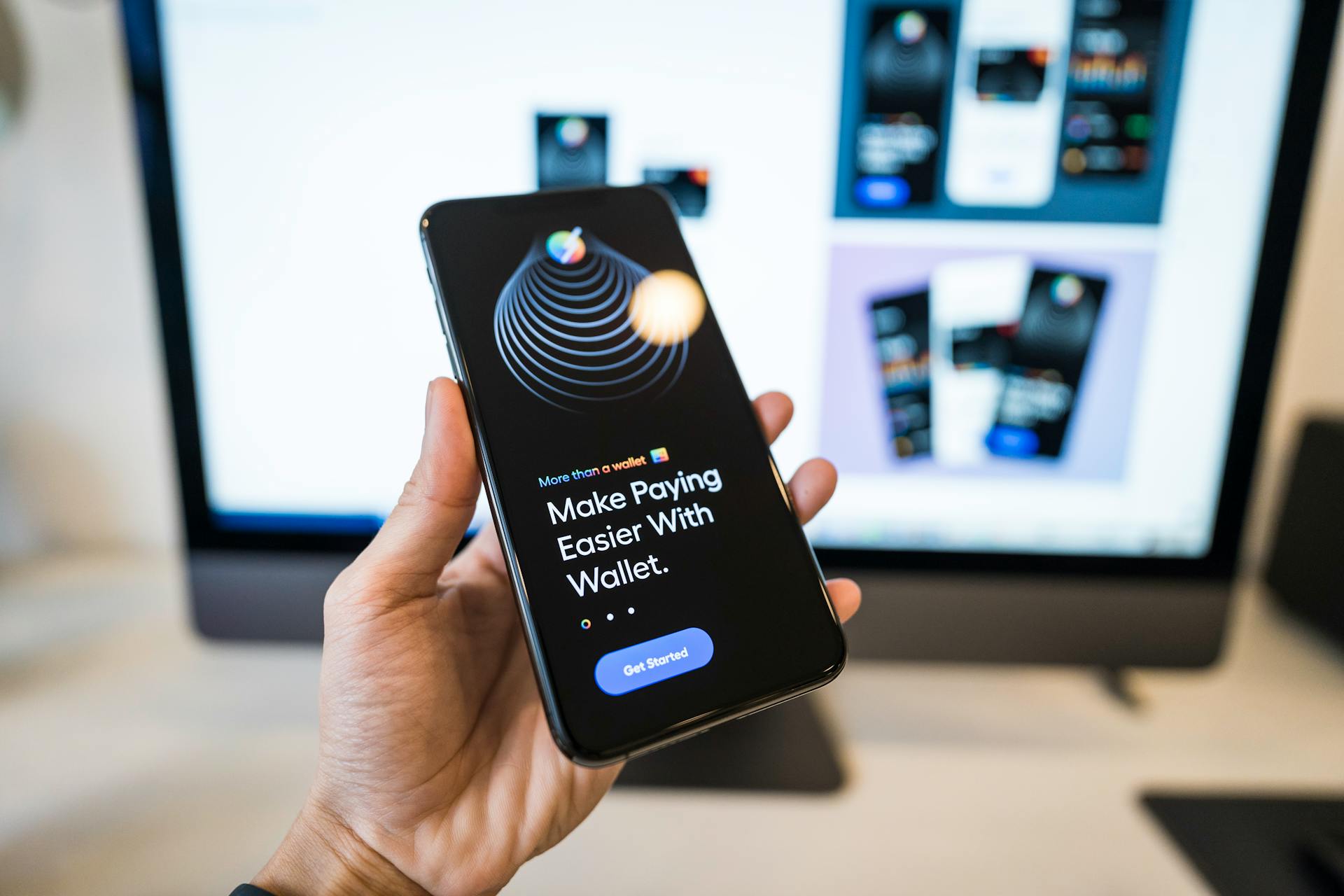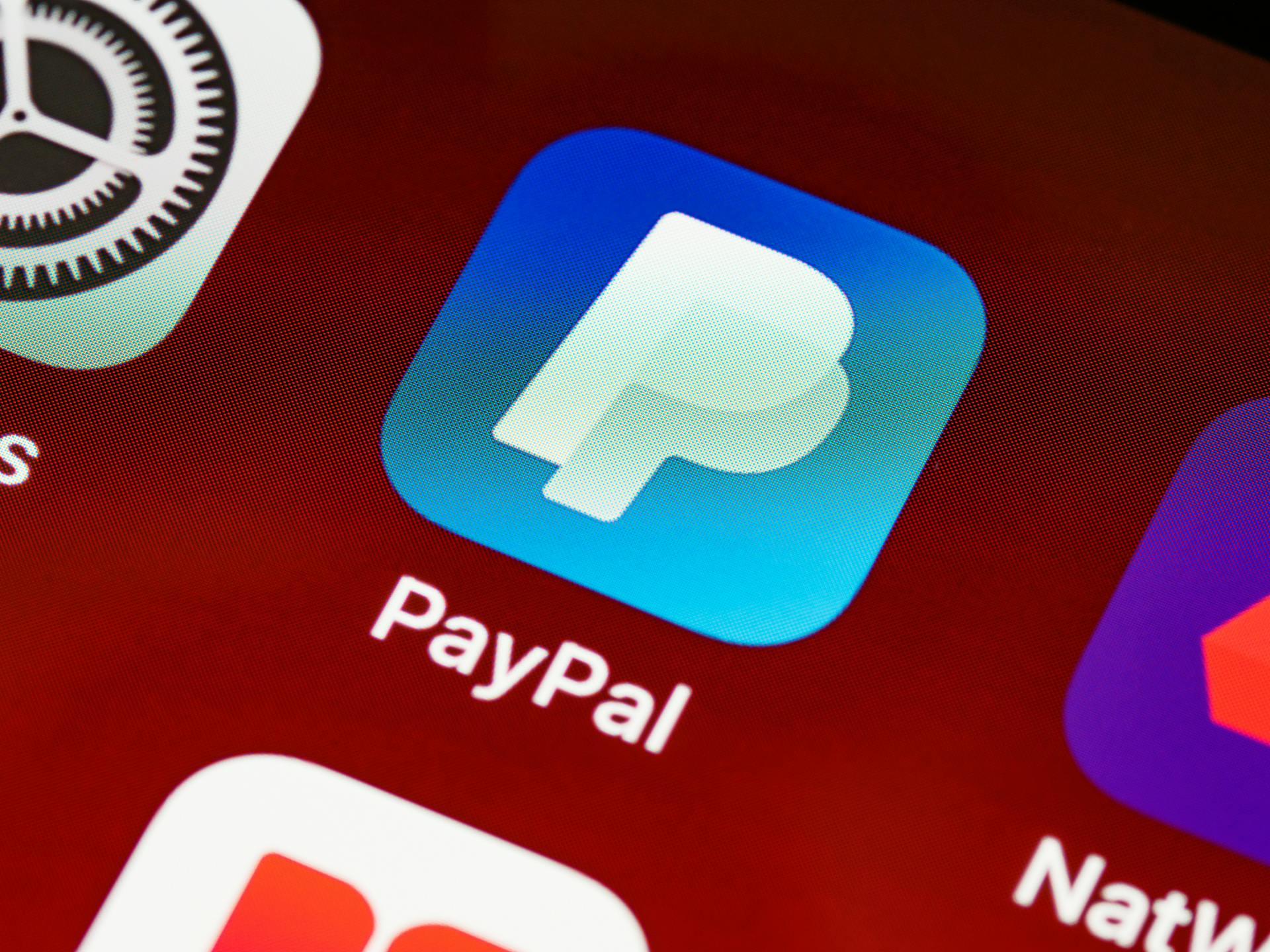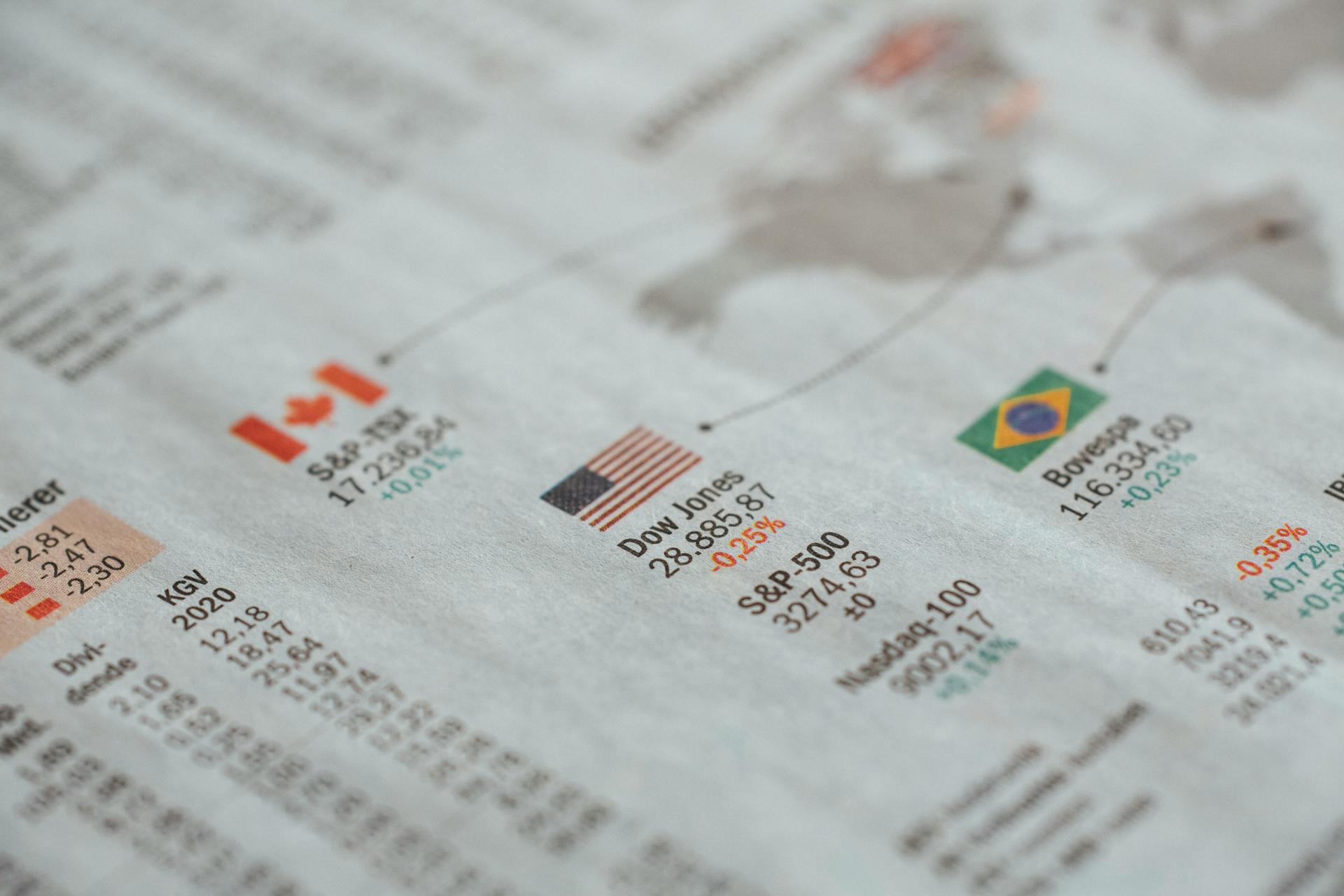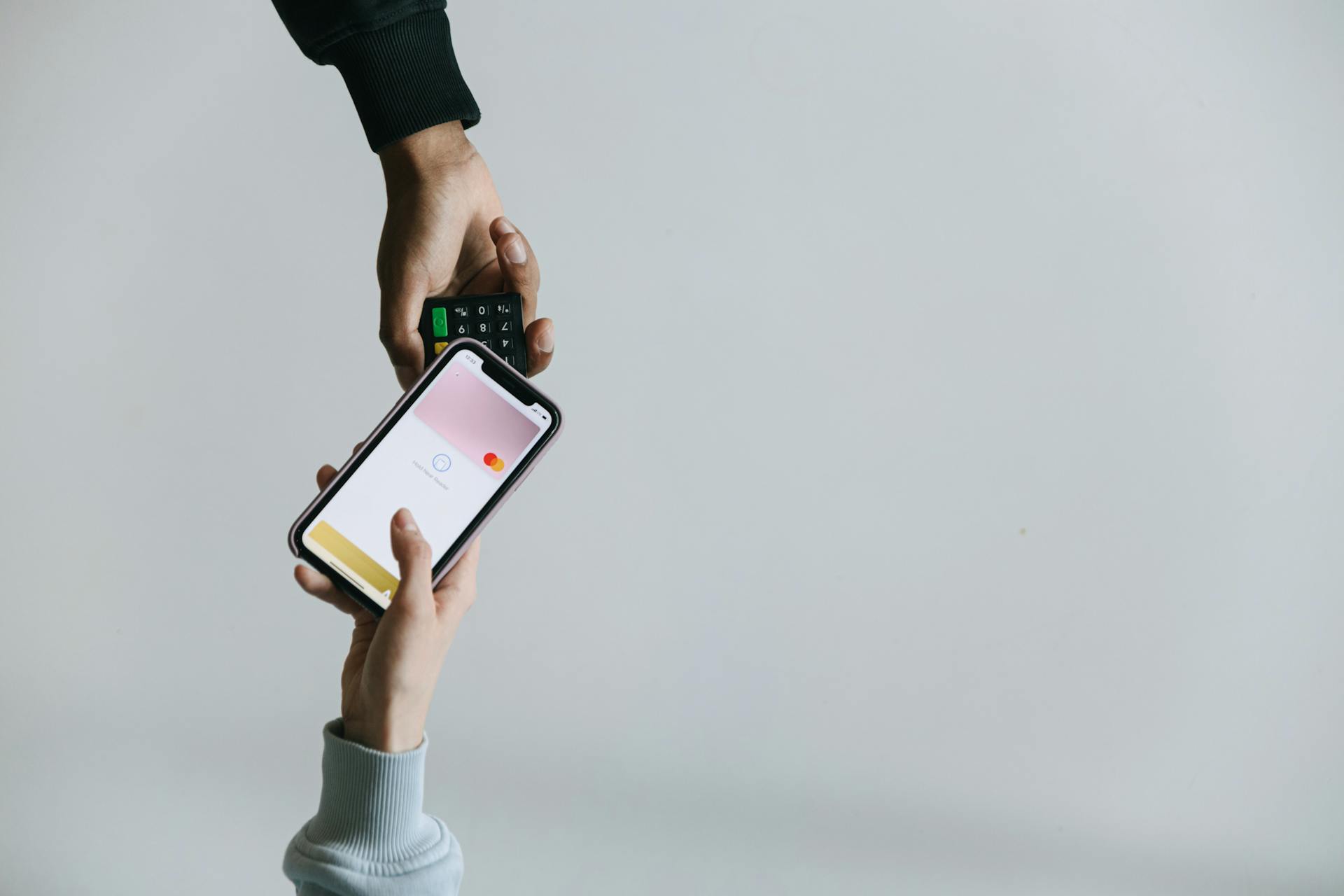
Mobile wallets have revolutionized the way we make payments, offering a convenient and secure way to buy and sell goods and services.
Apple Pay, for instance, allows users to store their credit and debit cards on their iPhone, making it easy to make contactless payments.
Google Pay is another popular mobile wallet that supports a wide range of payment methods, including credit and debit cards, as well as bank accounts.
PayPal is a well-established mobile wallet that allows users to send and receive money online, making it a popular choice for online transactions.
Mobile wallets have also made it easier to make payments in-store, with many retailers supporting contactless payments through services like Apple Pay and Google Pay.
Here's an interesting read: Apple Pay Online Payments
What Is a Mobile Wallet?
A mobile wallet is a digital version of a physical wallet that stores your payment information and other card details. It's essentially a digital container that holds your credit and debit cards, loyalty cards, and even tickets.
Mobile wallets can be accessed through your smartphone or tablet, making it easy to make payments on the go. You can use it to pay for goods and services at stores, restaurants, and online.
One of the most popular mobile wallets is Apple Pay, which allows you to add your credit or debit card to your iPhone or Apple Watch. With Apple Pay, you can make payments by holding your device near a payment terminal.
Google Pay is another well-known mobile wallet that lets you add your credit or debit card to your Android device. It's compatible with many payment terminals and can be used to make payments in stores and online.
Mobile wallets are not just for payments; they can also store loyalty cards, such as those from your favorite coffee shop or supermarket. This means you can earn rewards and points without having to carry around a physical card.
Additional reading: E Wallet Payment
Types of Mobile Wallets
There are three main types of mobile wallets: open wallets, semi-closed wallets, and mobile banking apps. Mobile banking apps are an additional tool that lets customers manage their finances on the go, but they don't usually work for in-person, contactless purchases.
Open wallets are the most flexible type, letting users transfer funds or withdraw money remitted to their account in cash at ATMs. Examples of open wallets include PayPal, Apple Pay, Google Pay, Zelle, and Venmo.
Semi-closed wallets are more limited, allowing users to receive money into their bank accounts but not cash withdrawal. They can transfer funds to others using the same payment portal. Examples of semi-closed wallets include Stripe, Square, and PayTM.
Here's a quick rundown of the different types of mobile wallets:
Types of Apps
Mobile wallets come in different forms, each with its own set of features and capabilities. Some mobile wallets are designed to be used in-store, while others are more geared towards online transactions.
A different take: Ethereum Wallets
There are three main types of mobile wallets: open wallets, semi-closed wallets, and mobile banking apps.
Open wallets are the most flexible type, allowing users to transfer funds or withdraw money at ATMs. Examples of open wallets include PayPal, Apple Pay, Google Pay, Zelle, and Venmo.
Semi-closed wallets, on the other hand, are more limited in their capabilities. They let users receive money into their bank accounts but don't allow cash withdrawal. Examples of semi-closed wallets include Stripe, Square, and PayTM.
Mobile banking apps are a type of mobile wallet that lets customers manage their finances on the go. They often include features such as transferring money between accounts, paying bills, and viewing transaction history.
Here are some examples of mobile wallets, categorized by type:
Mobile wallets like Apple Pay and Google Pay are expected to nearly double in use between 2020 and 2025, making them a popular choice for retailers and consumers alike.
Check Integrations and Compatibility
When choosing a mobile wallet, it's essential to consider how well it will integrate with your existing business tools.
Check whether the mobile payment app will integrate well with your accounting software or ecommerce platform.
Make sure the app is compatible with your hardware, especially if your business has a physical presence.
For example, if you have a point-of-sale system, the mobile wallet should be able to work seamlessly with it.
Integrations can save you time and reduce errors in your transactions.
Research the mobile wallet's compatibility with your specific hardware and software to ensure a smooth experience.
Check this out: Hardware Wallet vs Software Wallet
Tokenization
Tokenization is a key feature of mobile wallets that protects sensitive data from theft or manipulation. It replaces sensitive personal data during transactions with a temporary series of numbers called a token.
This token is a unique identifier that allows customers to make payments without revealing their primary account number (PAN) of the credit card. The token is generated once payment details are collected.
The encrypted token is then sent to the merchant's payment processor, which is responsible for processing and verifying the transaction. If the authorization is successful, the transaction via mobile wallet is complete.
Benefits of Mobile Wallets
Mobile wallets offer a range of benefits that make them an attractive option for consumers and merchants alike.
One of the key advantages of mobile wallets is their convenience. With mobile wallets, customers can complete transactions on the go using their phones or devices, making it easier to shop and increasing customer satisfaction. In fact, 43% of customers would pay more for greater convenience.
Mobile wallets also provide an added layer of security. For instance, Square verifies customers with a photo ID, ensuring that transactions are secure and reducing the risk of unauthorized use.
Another benefit of mobile wallets is their speed. Mobile wallet transactions are quicker than traditional payment methods, often taking just a few seconds to complete. This is particularly beneficial for merchants, who can reduce wait times and increase operational efficiency.
Here are some of the key benefits of mobile wallets:
- Security
- Convenience
- Speed
In fact, 54% of mobile transactions worldwide are expected to take place via remote purchases and NFC by 2017, highlighting the growing importance of mobile wallets.
Mobile wallets also provide merchants with valuable insights into customer behavior, allowing them to offer personalized benefits, recommendations, and deals to loyal customers. This can be a major selling point for retailers, who can use mobile wallets to integrate promotions into a payment plan and access valuable customer data.
Overall, mobile wallets offer a range of benefits that make them an attractive option for consumers and merchants alike. By providing convenience, security, and speed, mobile wallets can help to increase customer satisfaction, reduce wait times, and boost operational efficiency.
Popular Mobile Wallets
Mobile wallet options have become increasingly popular, making it easier to send and receive payments. Venmo is one such option, allowing users to split bills or pay for goods with just a few taps.
To use Venmo, retailers need to add some personal details and link a bank account or debit card. This makes it easy to send payments to customers, who can choose the recipient, add the correct amount, and send the payment.
Some mobile payment apps, like Venmo, offer a range of features, including the ability to search for users by name, email, or personal QR code. This makes it simple for customers to find and pay friends or businesses.
Check this out: Send Money to Mobile Wallet
Apple Pay
Apple Pay is a popular mobile wallet that lets users make contactless payments both in person and online. It's widely accepted and has no fees associated with it.
To use Apple Pay, you need to connect your debit and credit cards to your Apple Wallet. This can be done by capturing the details from your cards using your device's camera. Banks typically need to verify these details before you can start making payments.
One of the benefits of Apple Pay is its easy integration with Apple services. This makes it a convenient option for users who are already invested in the Apple ecosystem.
Here are some key benefits of using Apple Pay:
- No fees
- Widely known and accepted
- Easy integration with Apple services
Apple Pay is a good option for physical and online stores that want to offer contactless payment options. It's also suitable for businesses in areas with high Apple device usage.
Choosing the Best Method for Your Business
To choose the best mobile payment method for your business, consider three key factors: customer behavior, transaction fees, and security features.
Customer behavior is crucial, as you want to offer methods that your customers are already using and comfortable with. For example, if your customers are predominantly using a specific mobile wallet, it's a good idea to offer that method.
Transaction fees can add up quickly, so it's essential to choose a method that offers competitive rates. Some mobile payment methods charge higher fees than others, so be sure to do your research.
Security features are also vital, as you want to protect your customers' sensitive information. Look for methods that use encryption and two-factor authentication to ensure their transactions are secure.
Ultimately, the best method for your business will depend on your specific needs and customer base.
Accepting Mobile Payments
Accepting mobile payments is a must-have for any business that wants to stay competitive. Around 47% of consumers say they won't shop at a store that doesn't offer contactless payment.
To start accepting mobile payments, you need to advertise that you accept mobile wallets. Inform customers that they can pay with their mobile wallets by adding retail signage at the payment terminal explaining which mobile wallet types you accept.
A unique perspective: Why No T Mobile in Nebraska?
You should also consider posting a simple contactless logo alongside the names of the mobile wallets to encourage customers to use them when paying at checkout. This is a simple yet effective way to let customers know they can pay with their mobile wallets.
Some benefits of accepting mobile payments include speeded up check-out times and ease of use. Mobile payments can also be super secure, such as in the case of Square which verifies customers with a photo ID.
Here are some key facts to consider when deciding whether to accept mobile payments:
- No fees
- Widely known and accepted
- Easy integration with Apple services
- Physical and online stores that want to offer contactless payment options
- Businesses in areas with high Apple device usage
- Physical stores that want to offer contactless payment options
Security and Fees
Mobile wallets are considered a more secure way to make payments. They use tokenization as a security feature to help protect sensitive account data.
Mobile wallets are held in a mobile device, which requires a passcode, face identification, or fingerprint scan to unlock before making a payment. This adds an extra layer of security.
In-person payments with mobile wallets come with a fee of 2.29% + $0.09 for each transaction.
Broaden your view: Mobile Wallet Security
You can minimize the risk of your digital wallet being hacked by following normal security precautions, including using unique passwords and enabling 2FA (two-factor authentication).
Here's a breakdown of the costs associated with mobile wallets:
Security
Mobile wallets are considered a more secure way to make payments, thanks to tokenization as a security feature. This helps protect sensitive account data.
Digital wallets use a form of encryption called tokenization to keep your card details secure. It replaces your card number with a unique, random string of numbers.
To minimize the risk of your digital wallet being hacked, it's essential to follow normal security precautions. This includes using unique passwords and enabling 2FA (two-factor authentication).
If you're a cardholder in the EU, digital wallets have to comply with SCA (secure customer authentication) requirements. This involves requiring cardholders to provide any two of the following together:
- Something they know, e.g. a password or a PIN
- Something they have, e.g. a one-time code sent to their smartphone
- Something they are, e.g. a form of biometric authentication like a fingerprint or face identification
Fees
Fees can add up quickly, so it's essential to understand what you're paying for. There are no monthly fees for the basic account, which is a great starting point.

If you upgrade to a premium account, you can expect to pay between $5 and $30 per month. This can be a worthwhile investment if you need more features and benefits.
In-person payments come with a fee of 2.29% plus $0.09 per transaction. This can be a significant cost if you're processing a lot of transactions in person.
Online payments are a bit more expensive, with fees ranging from 2.59% plus $0.49 to 3.49% plus $0.49 per transaction. This can add up quickly, so be sure to factor it into your pricing strategy.
If you need to accept in-person payments, don't forget to factor in hardware costs for card readers and POS systems. These costs can add up quickly, so be sure to budget for them.
Here's a breakdown of the fees you can expect to pay:
- No monthly fees for the basic account
- $5–$30 for upgraded accounts
- In-person payments are 2.29% + $0.09 for each transaction
- Online payments are between 2.59% + $0.49 and 3.49% + $0.49 for each transaction
Industry and Trends
The fintech industry is growing at an incredible rate, with the user base for digital payments expected to cross 5,480.00 million by 2027.
The market for digital payments was worth around $4 trillion in 2020 and is projected to reach $10 trillion by 2026, according to Statista.
The use of eWallet apps like Apple Pay, Google Pay, and Samsung Pay is expected to double between 2020 and 2025, showcasing the rapid growth of the market.
Here are some key statistics on the growth of digital payments:
- The market size of eWallets was around $85.6 Billion in 2022 and reached $105.5 Billion in 2023.
- The eWallet market is expected to hit $567.2 Billion by 2032.
- Transactions worth $16 Trillion are expected to be made through eWallets by 2028.
The Industry of Mobile Wallets
The industry of mobile wallets is a rapidly growing space, with a huge user base expected to cross 5,480.00 million by 2027.
The market for digital payments, which includes mobile wallets, is expected to reach $10 trillion by 2026, up from $4 trillion in 2020. This growth is driven by the increasing demand for eWallet apps, which are expected to double in use between 2020 and 2025.
The eWallet market size was around $85.6 Billion in 2022 and reached $105.5 Billion in 2023, indicating a significant growth rate. If this trend continues, the market is expected to hit $567.2 Billion by 2032.
Here's a brief overview of the expected growth in the digital payments industry:
- The User Base for Digital Payments is Expected to Cross 5,480.00 Million by 2027
- Market size of eWallets is expected to reach $567.2 Billion by 2032
- Use of eWallet apps like Apple Pay, Google Pay, & Samsung Pay will double between 2020 and 2025
- Transactions worth $16 Trillion are expected to be facilitated by eWallets by 2028
Technology's Impact on Customer Purchasing Decisions
Technology is shaping the way customers make purchasing decisions, and experts at E-Complish are shedding light on this phenomenon.
Technology influences customer purchasing decisions, as seen in how e-commerce platforms like E-Complish are changing the shopping landscape.
The rise of e-commerce has led to increased online shopping, with many consumers now preferring to shop online rather than in physical stores.
E-Complish's consumer behavior insights reveal that technology is a significant factor in shaping shopping choices, with many consumers relying on online reviews and product information before making a purchase.
In fact, a significant majority of consumers trust online reviews as much as personal recommendations, according to E-Complish's research.
The convenience of online shopping and the ability to compare prices and products easily are key drivers of this trend.
As a result, businesses are shifting their focus to online platforms to reach their target audience and stay competitive in the market.
Customer Loyalty vs Invasion
The mobile wallet frenzy has created a technological buzz that may not be particularly consumer-centric, wiping out the focus on offering tangible benefits to customers.
A branded app that enables consumers to make payments and enjoy other benefits can be a successful solution for retailers. Dunkin Donuts has seen recent success with its mobile app, powered by its existing gift card system.
Merchants need to keep in focus the importance of offering a tangible benefit to the customer, rather than just mining and manipulating their valuable customer data. This approach is crucial for building customer loyalty.
The Starbucks app operated in a similar manner, but it appears they are now taking things to the next level in terms of payment functionality with their recent investment in Square.
Worth a look: Hot Wallet App
Frequently Asked Questions
Is Zelle a mobile wallet?
No, Zelle is not a mobile wallet, but rather a peer-to-peer payment service that facilitates transfers between bank accounts. It's designed for sending and receiving money, not storing it like a wallet.
Sources
- https://www.invoicesimple.com/blog/mobile-payment-methods
- https://www.shopify.com/retail/mobile-wallets
- https://www.nimbleappgenie.com/blogs/ewallet-vs-digital-wallet-vs-mobile-wallet/
- https://www.getmoss.com/guide/en/digital-wallets/
- https://e-complish.com/blog/mobile-payments-101-the-difference-between-mobile-wallets-and-mobile-payments/
Featured Images: pexels.com


